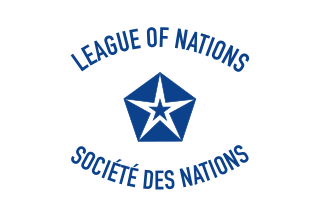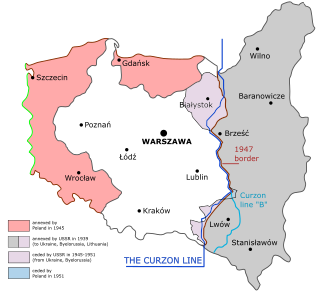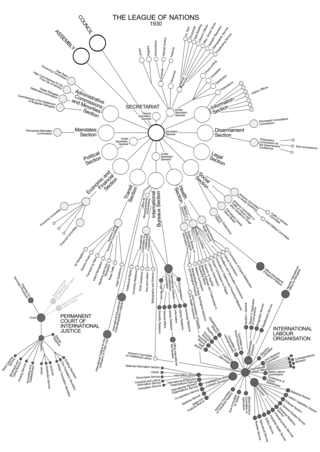
The League of Nations was the first worldwide intergovernmental organisation whose principal mission was to maintain world peace. It was founded on 10 January 1920 by the Paris Peace Conference that ended the First World War. The main organisation ceased operations on 18 April 1946 when many of its components were relocated into the new United Nations. As the template for modern global governance, the League profoundly shaped the modern world.

The Treaty of Versailles was a peace treaty signed on 28 June 1919. As the most important treaty of World War I, it ended the state of war between Germany and most of the Allied Powers. It was signed in the Palace of Versailles, exactly five years after the assassination of Archduke Franz Ferdinand, which led to the war. The other Central Powers on the German side signed separate treaties. Although the armistice of 11 November 1918 ended the actual fighting, and agreed certain principles and conditions including the payment of reparations, it took six months of Allied negotiations at the Paris Peace Conference to conclude the peace treaty. Germany was not allowed to participate in the negotiations before signing the treaty.

Following their defeat in World War I, the Central Powers agreed to pay war reparations to the Allied Powers. Each defeated power was required to make payments in either cash or kind. Because of the financial situation in Austria, Hungary, and Turkey after the war, few to no reparations were paid and the requirements for reparations were cancelled. Bulgaria, having paid only a fraction of what was required, saw its reparation figure reduced and then cancelled. Historians have recognized the German requirement to pay reparations as the "chief battleground of the post-war era" and "the focus of the power struggle between France and Germany over whether the Versailles Treaty was to be enforced or revised."

The San Remo conference was an international meeting of the post-World War I Allied Supreme Council as an outgrowth of the Paris Peace Conference, held at Castle Devachan in Sanremo, Italy, from 19 to 26 April 1920. The San Remo Resolution passed on 25 April 1920 determined the allocation of Class "A" League of Nations mandates for the administration of three then-undefined Ottoman territories in the Middle East: "Palestine", "Syria" and "Mesopotamia". The boundaries of the three territories were "to be determined [at a later date] by the Principal Allied Powers", leaving the status of outlying areas such as Zor and Transjordan unclear.

The Fourteen Points was a statement of principles for peace that was to be used for peace negotiations in order to end World War I. The principles were outlined in a January 8, 1918 speech on war aims and peace terms to the United States Congress by President Woodrow Wilson. However, his main Allied colleagues were skeptical of the applicability of Wilsonian idealism.

The Locarno Treaties were seven post-World War I agreements negotiated amongst Germany, France, Great Britain, Belgium, Italy, Poland and Czechoslovakia in late 1925. In the main treaty, the five western European nations pledged to guarantee the inviolability of the borders between Germany and France and Germany and Belgium as defined in the Treaty of Versailles. They also promised to observe the demilitarized zone of the German Rhineland and to resolve differences peacefully under the auspices of the League of Nations. In the additional arbitration treaties with Poland and Czechoslovakia, Germany agreed to the peaceful settlement of disputes, but there was notably no guarantee of its eastern border, leaving the path open for Germany to attempt to revise the Versailles Treaty and regain territory it had lost in the east under its terms.

The Paris Peace Conference was a set of formal and informal diplomatic meetings in 1919 and 1920 after the end of World War I, in which the victorious Allies set the peace terms for the defeated Central Powers. Dominated by the leaders of Britain, France, the United States and Italy, the conference resulted in five treaties that rearranged the maps of Europe and parts of Asia, Africa and the Pacific Islands, and also imposed financial penalties. Germany, Austria-Hungary, Turkey and the other losing nations were not given a voice in the deliberations; this later gave rise to political resentments that lasted for decades. The arrangements made by this conference are considered one of the great watersheds of 20th-century geopolitical history.

The Curzon Line was a proposed demarcation line between the Second Polish Republic and the Soviet Union, two new states emerging after World War I. Based on a suggestion by Herbert James Paton, it was first proposed in 1919 by Lord Curzon, the British Foreign Secretary, to the Supreme War Council as a diplomatic basis for a future border agreement.

The causes of World War II have been given considerable attention by historians. The immediate precipitating event was the invasion of Poland by Nazi Germany on September 1, 1939, and the subsequent declarations of war on Germany made by Britain and France, but many other prior events have been suggested as ultimate causes. Primary themes in historical analysis of the war's origins include the political takeover of Germany in 1933 by Adolf Hitler and the Nazi Party; Japanese militarism against China, which led to the Japanese invasion of Manchuria and the Second Sino-Japanese War; Italian aggression against Ethiopia, which led to the Second Italo-Ethiopian War; the Soviet Union's desire to reconquer old territories of the Russian Empire, which led to the Soviet invasion of Poland, the Soviet occupation of Bessarabia and Northern Bukovina, the occupation of the Baltic states and the Winter War.

The Polish–Lithuanian War was an undeclared war fought in the aftermath of World War I between newly independent Lithuania and Poland, with fighting mainly in the Vilnius and Suwałki regions, which was part of the Lithuanian Wars of Independence and lasted from May 1919 to 29 November 1920. Since the spring of 1920, the conflict happened alongside the wider Polish–Soviet War and was affected by its progress. It was subject to unsuccesful international mediation at the Conference of Ambassadors and the League of Nations.
The Supreme War Council was a central command based in Versailles that coordinated the military strategy of the principal Allies of World War I: Britain, France, Italy, the United States, and Japan. It was founded in 1917 after the Russian Revolution and with Russia's withdrawal as an ally imminent. The council served as a second source of advice for civilian leadership, a forum for preliminary discussions of potential armistice terms, later for peace treaty settlement conditions, and it was succeeded by the Conference of Ambassadors in 1920.

The Conference for the Reduction and Limitation of Armaments, generally known as the Geneva Conference or World Disarmament Conference, was an international conference of states held in Geneva, Switzerland, between February 1932 and November 1934 to accomplish disarmament in accordance with the Covenant of the League of Nations. It was attended by 61 states, most of which were members of the League of Nations, but the USSR and the United States also attended.

The remilitarisation of the Rhineland began on 7 March 1936, when military forces of Nazi Germany entered the Rhineland, which directly contravened the Treaty of Versailles and the Locarno Treaties. Neither France nor Britain was prepared for a military response, so they did not act. After 1939, commentators often said that a strong military move in 1936 might have ruined the expansionist plans of Adolf Hitler, the dictator of Germany. However, recent historiography agrees that both public and elite opinion in Britain and France strongly opposed a military intervention, and neither had an army prepared to move in.

The Sejny Uprising or Seinai Revolt refers to a Polish uprising against the Lithuanian authorities in August 1919 in the ethnically mixed area surrounding the town of Sejny. When German forces, which occupied the territory during World War I, retreated from the area in May 1919, they turned over administration to the Lithuanians. Trying to prevent an armed conflict between Poland and Lithuania, the Entente drew a demarcation line, known as the Foch Line. The line assigned much of the disputed Suwałki (Suvalkai) Region to Poland and required the Lithuanian Army to retreat. While the Lithuanians retreated from some areas, they refused to leave Sejny (Seinai), because of its major Lithuanian population. Polish irregular forces began the uprising on August 23, 1919, and soon received support from the regular Polish Army. After several military skirmishes, Polish forces secured Sejny and the Lithuanians retreated behind the Foch Line.

René Massigli was a French diplomat who played a leading role as a senior official at the Quai d'Orsay and was regarded as one of the leading French experts on Germany, which he greatly distrusted.

The League of Nations was established with three main constitutional organs: the Assembly; the Council; the Permanent Secretariat. The two essential wings of the League were the Permanent Court of International Justice and the International Labour Organization.

On 3 September 1939, the United Kingdom declared war on Germany—two days after the German invasion of Poland. France also declared war on Germany later the same day.

The term Big Four Conference may refer to one of several conferences between heads of state or foreign ministers of the victorious nations after World War I (1914–18) or during and after World War II (1939–45).
International relations (1919–1939) covers the main interactions shaping world history in this era, known as the interwar period, with emphasis on diplomacy and economic relations. The coverage here follows the diplomatic history of World War I and precedes the diplomatic history of World War II. The important stages of interwar diplomacy and international relations included resolutions of wartime issues, such as reparations owed by Germany and boundaries; American involvement in European finances and disarmament projects; the expectations and failures of the League of Nations; the relationships of the new countries to the old; the distrustful relations between the Soviet Union and the capitalist world; peace and disarmament efforts; responses to the Great Depression starting in 1929; the collapse of world trade; the collapse of democratic regimes one by one; the growth of economic autarky; Japanese aggressiveness toward China; fascist diplomacy, including the aggressive moves by Fascist Italy and Nazi Germany; the Spanish Civil War; the appeasement of Germany's expansionist moves toward the Rhineland, Austria, and Czechoslovakia, and the last, desperate stages of rearmament as another world war increasingly loomed.
The United Kingdom and the League of Nations played central roles in the diplomatic history of the interwar period 1920-1939 and the search for peace. British activists and political leaders helped plan and found the League of Nations, provided much of the staff leadership, and Britain played a central role in most of the critical issues facing the League. The League of Nations Union was an important private organization that promoted the League in Britain. By 1924 the League was broadly popular and was featured in election campaigns. The Liberals were most supportive; the Conservatives least so. From 1931 onward, major aggressions by Japan, Italy, Spain and Germany effectively ruined the League in British eyes.
















